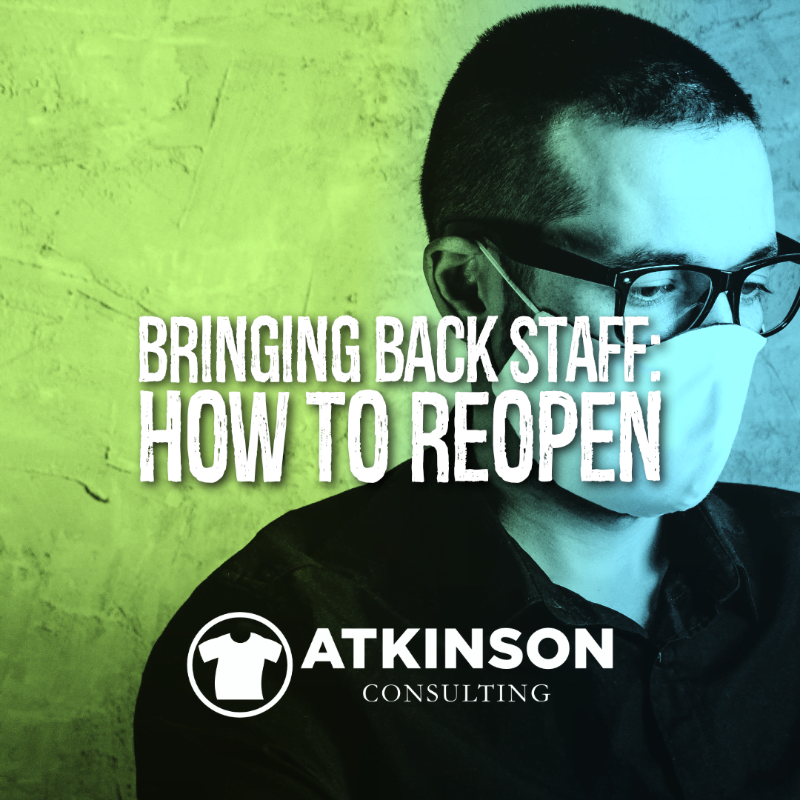If there is one question on every business owner’s brain right now, it’s this:
“How do we reopen for business?”
Some people have work trickling in, and it is looking promising. Others have accepted and have received government cash to help bring back employees. And there still are more business owners that are still in lockdown mode for a few weeks out, but are waiting for some signals to understand what to do.
There isn’t a one-size-fits-all approach to this.
However you look at it though, if your business survives this coronavirus event, your staff is going to return to work. Hopefully sooner rather than later.
Are you even thinking about what this means?
This article is designed to wrap your mind around that and get you thinking in regards to what that “new normal” might look like for managing your staff.
There are three main areas that you should focus on right now:
- Protecting your staff
- Managing future risks
- Ensuring productivity with new changes
Protecting Your Staff
What good will it do to bring your crew back from the COVID-19 quarantine, only to have challenges later?
This means that you are going to have to reexamine your standard operating procedures, formalize any new health-oriented processes, build adequate training, and ensure accountability with your team. Frankly, easier said than done.
Without your team working and handling all of the tasks of your business, things will grind to a standstill. As you probably just found out, it’s hard running your company by yourself.
Standard Operating Procedures
You have these, right?
For a lot of the businesses I work with, in the beginning, they have more of an oral tradition on how things are handled than anything written. (That’s one of the things I help build, by the way) In this instance, let’s focus on the SOP’s of health and safety, and not so much on individual work-related tasks.
Here, let’s focus on the hygiene of the shop.
Frankly, I’ve been to plenty of facilities, and there is a wide range of cleanliness and organization. Some take this very seriously and the shop is surgical-room clean. Other shops look like a tornado just swept through. Most are somewhere in the middle.
Where does your shop fit in?
The ones that do a good job of keeping things clean and organized probably have a good handle on how to clean and disinfect their shop already.
Studies have shown that the coronavirus lasts up to 3 hours in the air, 24 hours on cardboard, 2 to 3 days on stainless steel, and 3 days on plastic. Those exist in your business right now.
Here’s what you should think about:
- What surfaces will you need to clean constantly? Maybe a few times a day? Light switches, bathrooms, doorknobs, timeclocks, phones, commonly used keyboards, metal surfaces, vending machines, break rooms, countertops, and more. It’s going to be a big list.
- Who will be doing this work? When should they do it?
- What supplies will you need? Do you have them in an adequate quantity?
- What about hand sanitizer stations or soap?
- Personal Protection Equipment. Masks, gloves, hand sanitizer. What will you need? How much will you need? As an employer, you need to supply this.
- Are you checking temperatures with a forehead scanner? Do you have one? What is the ruling for this in your state?
- How will the work change with physical distancing? Walk around and think this through before bringing your crew back to work. Develop new ideas.
- Are you staggering breaks and lunchtimes to limit the number of people in the breakroom at one time?
- How will you know that things are being handled properly?
- Are you disinfecting boxes and cartons as they come in with a spray?
- When customers, visitors, suppliers, and other guests come into the shop, what are they touching? Limit access to areas to prevent having to constantly disinfect more spaces in your shop.
Your team will be anxious about working. There is a mental aspect to this too, as everyone will be worried about either getting or transmitting the coronavirus. Don’t take this lightly.
The best thing you can do is to manage the circumstances with as much calmness and clarity that you have. Be positive and enthusiastic.
As a leader, they are looking to you to comprehend the situation. Your company needs to set up the rules and guidelines in place before everyone comes back, so people will know what to do. You don’t want to simply wing it.
These should be written. If they are not written down, they don’t count.
Managing Future Risks
These are unprecedented times we are living in these days. It feels weird to even open up and get back to work, and even though everyone wants to desperately find their way back financially, nobody wants to create a bigger problem down the line regarding health.
This means that you need to be thinking a few steps ahead and start working on plans to mitigate the risks associated with opening back up for business.
Here are a few points to consider:
- What happens if a team member gets sick? Are you paying them to stay home? If so, for how long? Write your policy here and communicate it to your team.
- If you are not paying them to stay home, are you prepared for the eventual contamination and havoc that a virus carrier may inflict on your business and staff?
- If someone is sick, can they get testing? In some areas, this is available, and in others, it is harder to obtain. You need to know where to get testing in your area to keep your employees safe and send someone to get testing. Also, are you paying for it if there is a fee? Make sure you have the answers to this, as someone on your staff will ask.
- Can you increase ventilation and bring in an abundance of fresh air? Nobody is certain, but how will the temperature or humidity have an effect on the virus. When that information is released, how does that match up to your facility’s environmental conditions?
- Will you need to remove all of your carpet in the office, as that can’t be easily cleaned?
- Communicate constantly the need to wear PPE and hand washing. Don’t just say it once. You may need to talk about it every day, or even several times a day. Stay vigilant.
- Can you purchase PPE that is washable or sterilizable? It may be more expensive initially but look at the long term cost of reusing rather than using new items every day.
- “Planning is anticipatory decision making.” What happens when you bring everyone back, but people start to fall ill? Or, what if your area goes back into a stay at home order? We don’t want these things to happen but think ahead.
- What signs or instructions do you need to post? Where are you posting them? Who is writing or creating the message? Have these in place before your staff returns. It’s a new reality when everyone can see that you are taking things seriously.
- Who can work remotely? Your production team probably can’t, but sales, marketing, accounting, art, customer service, and other front-office type workers certainly can. Are you set up for that now? If not, what will you need?
Ensuring Productivity With New Changes
I think it is safe to say that nobody has all the answers. Your team will want to adapt to the new changes and will adjust. But being at work is not the same as being productive at work.
Here are some ideas to help you with that:
- Lead with clarity. What has to happen? What is mission-critical?
- Make it easy for people to do the right thing. Stay ahead of the curve.
- Be organized in thought and mission. Get the production schedule created today, for all the work tomorrow. Handle the scavenger hunt on what’s needed proactively, so people can focus on their tasks and not wandering around looking for answers. This will minimize contact with others.
- If you have new rules and guidelines, use them. Especially when it comes to safety. Have a plan. What if someone isn’t wearing their PPE, or is coughing all day? Talk about your plan with your team so they understand in advance their part in the accountability segment of working. There should be no surprises if you do it right.
- Will you have new employees or people helping out in unfamiliar roles? Make sure you have adequate training. Don’t just push people into the deep end of the pool and think they can swim.
- Empowered, trained people that are trusted work better and with higher quality than untrained, micro-managed people. Your job as a leader is to elevate the performance of your team, even in these difficult times. If you can’t trust your crew, you’ve hired the wrong people.
- Think about how communication normally happens. If there is a problem, a person might go find their supervisor or manager and talk to them face to face. But now, we want to limit contact. Could you use radios, text-messages, your cell phones, or other ways to find the answer?
- While you may need to insert more time into the day for cleaning, the importance of keeping running without having team members out sick outweighs the reason not to clean. Productivity only happens when the shop is open and operational. Standardize the hygiene process to ensure your company stays open.
- If you have employees out, a good way to understand who might fill in is using an Employee Skills Inventory checklist.
- Observation is a fantastic learning tool. Watch people work. With the new changes and maybe limited staff, where is everyone struggling? Make tweaks as necessary.
- How will social distancing work in your shop? What will you need to protect your crew? More tables? A plexiglass barrier on a stand between workers? Can a 6′ recommended distance work in your shop with the tasks that are performed? Think this through. Will you have to double up somewhere to get the same output?
- What if you staggered production? Will that help with social distancing? What would you need? Who is managing? How are you scheduling?
The Future Is Uncertain
The coronavirus pandemic will have long-lasting effects on our industry. Your shop is going to have to change the way you handle work in the building. Not just production, but the front office and sales as well.
Some shops are not allowing customer pickups. They are shipping everything. This may be a permanent change.
To ensure the health and safety of your staff, be sure to spend some time thinking things through on what “work” actually looks like in your company.
If you need help thinking through this quagmire, I’m happy to chat with you.
Book a call with me here.
“Get your facts first, then you can distort them as you please.” – Mark Twain
“If you hold a cat by the tail you can learn things that you cannot learn any other way.” – Mark Twain
“Do the right thing. It will gratify some people and astonish the rest.” – Mark Twain





